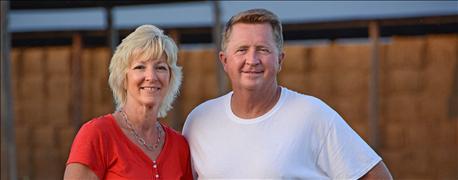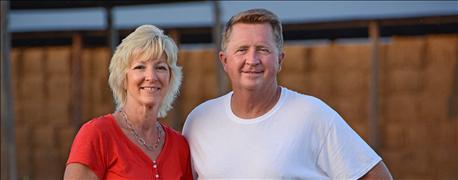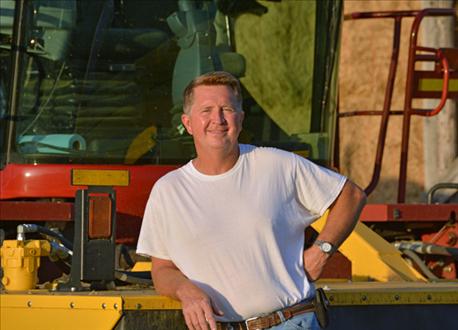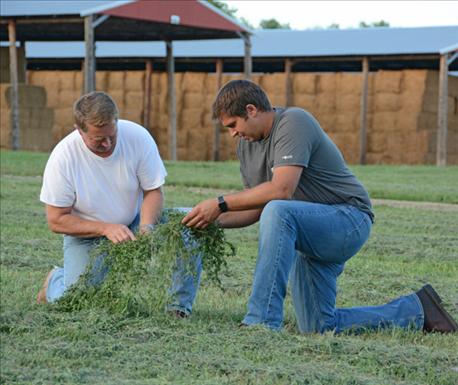October 3, 2016

Mike Brosnan loves the hay business. The Huron, S.D., farmer breaks out in a broad smile when he talks about growing alfalfa.
Mike, 58, grew up stacking small square bales for his dad. He took over the farm at age 28 when his dad died unexpectedly. He has expanded the farm into one of the largest alfalfa operations in the state.
“We are blessed,” Mike says. “We farm in one of the best alfalfa-producing parts of the country.”
Mike and his wife, Yvonne, and their daughter Jackie and her husband, Derik Kleinsasser, grow about 2,500 acres of alfalfa and 5,500 acres of corn and soybeans in the James River Valley south of Huron.

TAKES TWO: Michael and Yvonne Brosnan have worked together building their family’s hay business.
Their soils range from deep sand to heavy gumbo, but there’s a high water table under nearly all of it. Alfalfa’s deep roots can tap into the water to produce bumper yields of forage.
Central South Dakota’s climate is an asset for producing high-quality alfalfa. The hot, dry summers create near-perfect conditions for being able put up high-quality alfalfa.
“We have a bigger window than most other places to get it done right,” Mike says.
The Brosnans employ eight to 10 people during the haying and harvesting seasons. They run two New Holland discbine mower conditioners with 16-foot heads, five Rowse rakes and three Hesston large (3-by-4-by-8-foot) square balers with accumulators. They have two Hyundai wheel loaders and five 53-foot semis to load and transport bales. They have more than 10,000 tons of hay storage on the farm.
On an average day, they bale 160 acres of alfalfa in two hours. On a good day, they can put up more than 400 acres of alfalfa.

LOVES HAY BIZ: Mike Brosnan, standing in front of New Holland discbines, says he loves the hay business. He’s been in it all his life.
The size of the alfalfa enterprise is key to being able to deliver large volumes of high-quality and consistent-quality alfalfa to dairies.
“When you have 30- or 40-acre fields, it is hard to produce a large amount of hay that is the same quality. Nearly all of our fields are 160 acres or more,” Mike says.
Despite the size of the operation, he is always looking to make the one perfect bale.
It takes attention to detail from the moment the seed is selected to when the alfalfa is cut, raked, baled and stored away in a shed to consistently produce high-quality alfalfa, he says.
It also is a mix of science and art that Mike learned from his father, Walter.
Walter died in 1986 when Mike was 28. His mother had to sell all but two quarters of the farm to neighbors to settle the estate and Mike rented the remaining land. He kept growing hay and hauled it himself to their remaining customers. He also bought and sold hay, jockeying it to farms across the Midwest. As land became available to buy or rent, Mike gradually increased his own hay production.

KEY STEP: Mike Brosnan (left) and son-in-law Derik Kleinsasser check the condition of a windrow. Knowing when to bale is one of the key steps in producing the highest-quality alfalfa.
“I wanted to deliver high-quality alfalfa, and I really wanted to know the hay from start to finish,” Mike says.
Taking on more acres was challenging. He and Yvonne, a registered nurse, worked around the clock when they were haying.
“I worked at the clinic during the day and baled hay at night and then went back to the clinic in the morning,” says Yvonne, who now handles all the bookkeeping and operates equipment for the farm.
Their daughters, Jackie and Laura, operated equipment throughout their teenage years.
Today, Brosnan Farms markets alfalfa to dairies throughout the Midwest and Great Plains.
“We aren’t just selling alfalfa,” Mike says. “We’re selling a relationship that is centered around honesty, consistency and reliability. Honesty is No. 1. We have customers that buy 30 to 40 semiloads every year, and we have customers than only buy one or two. Most everyone who buys from us once calls again.”
Mike tests all their alfalfa to determine its relative feed value and other characteristics, and guarantees that customers will be satisfied.
Brosnan Farms offers longer-term contracts and honors contract prices even if the price of hay goes up. They can store customers’ hay until it is needed.
“I treat people like I would like to be treated,” Mike says.
It’s rewarding to be an alfalfa producer Mike says, but he doesn’t measure the reward just in profit.
In their office, Mike and Yvonne have a big envelope filled with letters and cards that they have received from customers.
“Thank you … our cows love your hay,” reads one letter.
“Thank you … the load of hay was exactly how you described it.”
A longtime customer from Sleepy Eye, Minn., wrote, “I don’t know what I’d do if you stopped raising alfalfa.”
“That’s the reward,” Mike says. “That’s why I love the hay business.”

INSIDE STORAGE: Hay sheds line a driveway on Brosnan Farms. The farm has storage for 10,000 tons.

BIG FIELDS: Alfalfa is grown in fields that are at minimum 160 acres in size. With large fields, it is possible to put up a large quantity of hay that is the same quality.

FAMILY BUSINESS: Mike and Yvonne (left, first and second row) operate Brosnan Farms with their daughter Jackie and son-in-law Derik Kleinsasser (right, second and first row). The Kleinsassers’ children are (left to right) Stella and Addison.
You May Also Like




